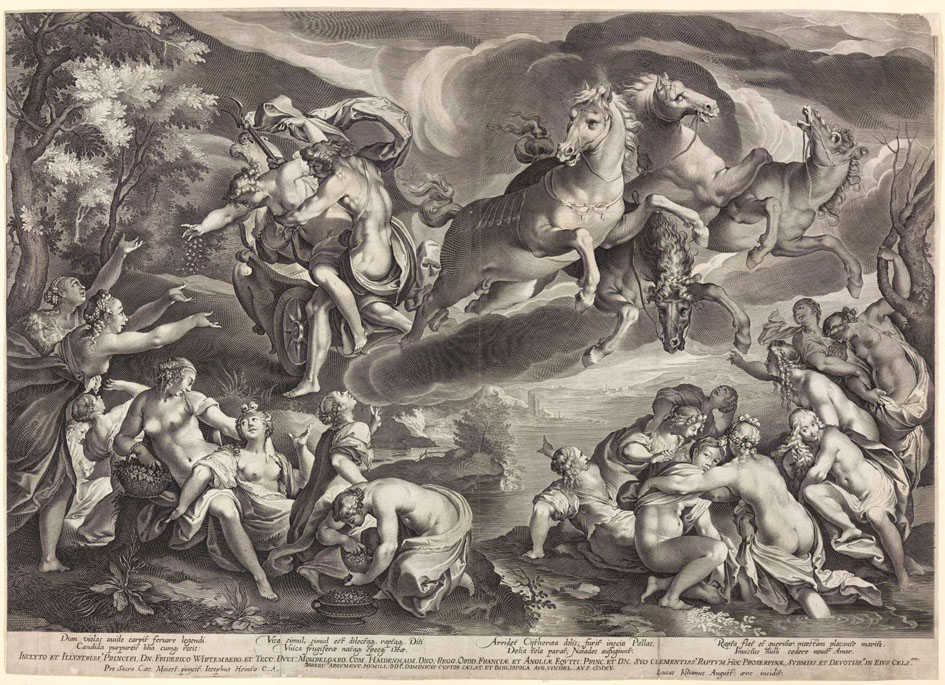Lukas and Wolfgang Kilian
Lucas Kilian (Augsburg 1579–1637) was the most prominent member of a dynasty of engravers and publisher in Augsburg 17th century Augsburg, and one of the most celebrated engravers of his time: Highly estimated as a draftsman and designer of ornamental prints, internationally acclaimed for his lively portrait engravings in allegorical frames in a proto-baroque style, and celebrated for his engravings after splendid mannerist compositions by the most eminent painters at the court of Rudolph II. in Prague – Bartholomaeus Spranger, Joseph Heintz the Elder, Hans von Aachen and Hans Rottenhammer – he was considered one of the most important engravers of his generation. Joachim von Sandrart praised him for ʽthe great number of his excellent works […] which are wonderfully executed’, and for which he ʽtruly deserves the second place after the world-reknowned Egidius Sadeler.’ (Teutsche Academie der Bau-, Bild- und Mahlerey-Künste, Nürnberg 1675, Part II. Book III, Chapter XXV.)
Lucas and his younger brother Wolfgang Kilian (Augsburg (1581–1662),the son of a goldsmith from Silesia who had settled in the prosperous Imperial city of Augsburg in the ate 16th century, were trained in the workshop of their stepfather Dominicus Custos (died in 1617), an experienced engraver and publisher who had emigrated from Antwerp. At the time, Augsburg provided a climate of relative religious tolerance to the mainly protestant artisans, who found a flourishing market located half way between Venice and the North. In his early years, Lucas had travelled to Venice and Italy, but clearly developed his technical skills on the model of the most innovative engraver of the time: Hendrick Goltzius. Wolfgang spent some time in the print shop of Giusto [Justus] Sadeler in Venice, a member of the internationally acclaimed Sadeler-Dynasty, whose relatives Raphael Sadeler and son, had settled at the nearby Munich court..
Around 1600, the city of Augsburg had become a center of the arts and crafts and was famous for the production of scientific instruments and fine silverware. The cityscape was modernized with an ambitious building program – splendid fountains and a new town hall – and the city officials decided to promote this new image through engravings by the Custos-Kilian-Dynasty. The most prominent product of this ambitious undertaking was Wolfgang Kilian’s ʽLarge map of Augsburg’ (1626), a detailed bird’s eye view of Augsburg based on precise measurements, and etched on six plates, which can compete in accuracy with Matthäus Merian’s famous cityscape of Basle.
The Custos workshop was well connected and had specialized in genealogical portrait series, a genre that the Kilian brothers brought to excellence in their monumental publication ʽFuggerorum et Fuggerarum Imagines’ (Augsburg 1620) for the Fugger-Dynasty, the most influential patrician family of merchants and entrepreneurs, renowned patrons of the arts and trendsetting collectors, who had been elevated to the rank of nobility in the 16th century already. The Augsburg art dealer Philipp Hainhofer was one of the great promoters of the Kilian-brothers, recommending their skills of portraiture in his letters to European courts. Since the Kilian brothers were related to the most sought after goldsmiths in the city, designs and ornamental prints by Lucas Kilian were adopted in practically all genres of the applied arts.
Lucas, who had taken over the Custos-house and workshop, continued to work as a portraitist for representatives of all ranks of society – the emperor, and the electors, princes and prelates, the Augsburg city officials, men of the sword, men of letters, and heroes of the Thirty-Years War. In his portrait of Grand Duke Ferdinando II de’ Medici commissioned as a present from the archducal court in Innsbruck, he recommended himself in a self-portrait in the image of St. Luke, patron saint of the painter’s and designer’s guild. Wolfgang founded his own workshop in 1621, just a few houses from his brothers home near Augsburg Cathedral, and formed his own trade mark embracing the motto: ʽLABOR IMPROBUS OMNIA VINCIT.’ Here, he presents himself as an etcher while his sons and collaborators are working on the printing press.
The Thirty Year’s war had terrible consequences for the city of Augsburg, and for the Kilian-brothers, and crushed the art market. After the death of his brother Lucas (1637), Wolfgang took up some of his older projects, and embarked on a second career specializing in book illustrations, and thesis prints, a new genre promoted by the catholic universities by the Jesuits and the Benedictine order, and he invested in the career of his talented sons, Bartholomäus and Philipp Kilian, who were trained in Paris and Italy, adopting new techniques and introducing a new baroque style to printmaking in Augsburg.
The New Hollstein volumes on Lucas and Wolfgang Kilian, based on Volume XVII (Lucas Kilian ) and XVIII (Wolfgang Kilian) of the Hollstein German Series, compiled by Robert Zijlma and edited by Fedja Anzelewsky and more recent publications, will provide new evidence on many aspects of the wide-ranging œuvre of the Kilian brothers. The introductory text compares preparatory drawings by Lucas Kilian to the masterpieces of his burin and refers to a wide range of new source material. The new catalogue significantly enlarges the work of both engravers, listing more than 1050 works for Lucas and almost 2300 entries for Wolfgang Kilian, based on research in prints and drawings collections, with online databases, and in book and print collections in major libraries across Europe.
Compiler: Susan Tipton
Editor: Hans-Martin Kaulbach


